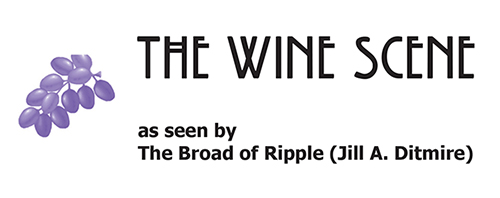
|
Broad Ripple Random Ripplings

The news from Broad Ripple
Brought to you by The Broad Ripple Gazette
(Delivering the news since 2004, every two weeks)

|
| Brought to you by: |

|

|

|

|

|

|
Converted from paper version of the Broad Ripple Gazette (v03n10)
The Wine Scene - by Jill A. Ditmire
posted: May 19, 2006

"JUDY'S KIDS" part two
The Broad Ripple Farmers' Market opens Saturday, May 27, 2006, from 8-noon behind Broad Ripple High School, and Capriole Goat Cheese is one of the two dozen featured vendors. A few years ago I visited its Southern Indiana farm to shoot an episode for my PBS TV show, "The Good Life". Here is part two of our three-part adventure with Judy Schad.
"In 1983 I had some of Laura Chenel's goat cheese and it changed everything. Until then I thought Jarlsberg was the hottest thing around," laughs Schad. That unique lemony, acidic, fresh flavor profile got Schad to experiment in her own kitchen making cheese from the abundance of milk from the then 120 goats on the farm. She made it for herself, then sold it at a local farmers' market. Soon demand increased, so she started production at the Huber Winery just a few miles from the Capriole Farm. Eventually she purchased that equipment and brought it back to the farm. Today 300 goats keep a year-round milk line, which results in local, national and international distribution of several varieties of Capriole Farms goat cheese. "Goats have much more personality than cows," says Schad as she continues to talk about the hands-on, personal style of the farm. A self-proclaimed "control freak" she manages this world-class operation with the help of a half dozen people. One of these people whom is her daughter Kate, oversees the actual production of the cheese.
"Would you like to see where we make the cheese?" asks Schad as she leads us into the small stone building nearby. She tells us that we need to shoot here first because once we head to the barns, the dirt, goats and smell won't be allowed in the highly sanitized cheese-making area. In fact, rubber boots line the walls of the short hallway from office to cheese making area - reminders again that this nationally acclaimed product starts simply.
Inside are large steel tanks of curds and milk covered with cheesecloth. A young hair-netted woman wraps rounds of goat cheese in parchment paper by hand and applies a label, then gently packs the product in wooden boxes. Judy tells my videographer that she thinks this would make a nice shot, and would he like for her to explain what takes place in this area. We say "yes" - and suddenly her schedule seems to have lightened a bit as she tells us how the cheese gets from goat to consumer.
"Its really like making three-day pickles," says Schad describing the process, which starts with pasteurized goats' milk and ends up in a variety of different sizes and shapes - some dusted with vegetable ash, some wrapped in brandy soaked chestnut leaves, some in long loaves. She tells us that the size of the product is what creates the flavor profile. The larger shapes take longer to ripen while the small round "Wabash Cannonballs" ripen quickly - both grow the same soft fuzzy mold on the outside. The mold makes the flavor, but the size determines how long it takes for those flavors to ripen. Each one starts with the same goat milk and mold, but ends up with its own flavor profile.
"Here," she says cutting and wrapping large chunks of the vegetable ash coated "Sophia" goat cheese. "Take this with you and have it with some of that Huber Wine at lunch," says Schad, handing me the soft, firm cheese. (Judy knows we are visiting the Huber Winery- just a few miles down the road from Capriole- to shoot a video piece there after our time with her.)
As we walk the short distance from the cheese factory to the weather beaten, gray goat barns, I remark on the beauty and tranquility of the farmstead. Judy tells me it's been in her husband's family for nearly 150 years. "But we didn't know that when we bought it," she says. "We discovered it belonged to his great, great grandfather when we were searching the deed." Destiny, no doubt about it.
SUNFLOWER SELECTION
Here's another wine for those who worry about sulfites: Orleans Hill Amador Zinfandel is made from 100 percent Zinfandel grapes - and those grapes are all certified organic. Orleans Hill takes the process one step further by meeting "sulfite free" guidelines for this wine. (See last edition of BRG for details on those guidelines.)
The result: a medium bodied dry red with earthy aromas and flavors of blackberry, cherry and white pepper. A great red for grilled beef as its style is more lean and mean than jammy.
Jill A. Ditmire is an Omnimedia wine specialist, AWS certified wine judge, freelance broadcast journalist and 20+ year home owner in the Warfleigh neighborhood of Broad Ripple. Send your questions and comments to Jill at jill@broadripplegazette.com
Also on INSTAGRAM @jaditmire
Also on INSTAGRAM @jaditmire
jill@broadripplegazette.com

|

|

|
| Brought to you by: |

|

|

|
| Brought to you by: |

|

|

|


